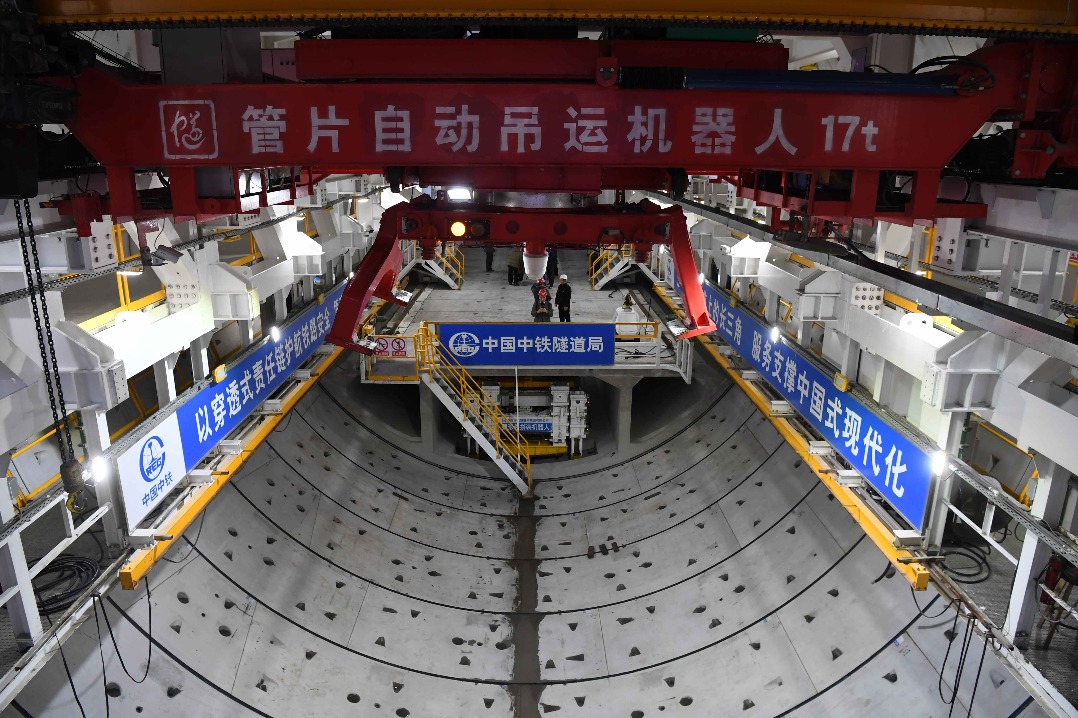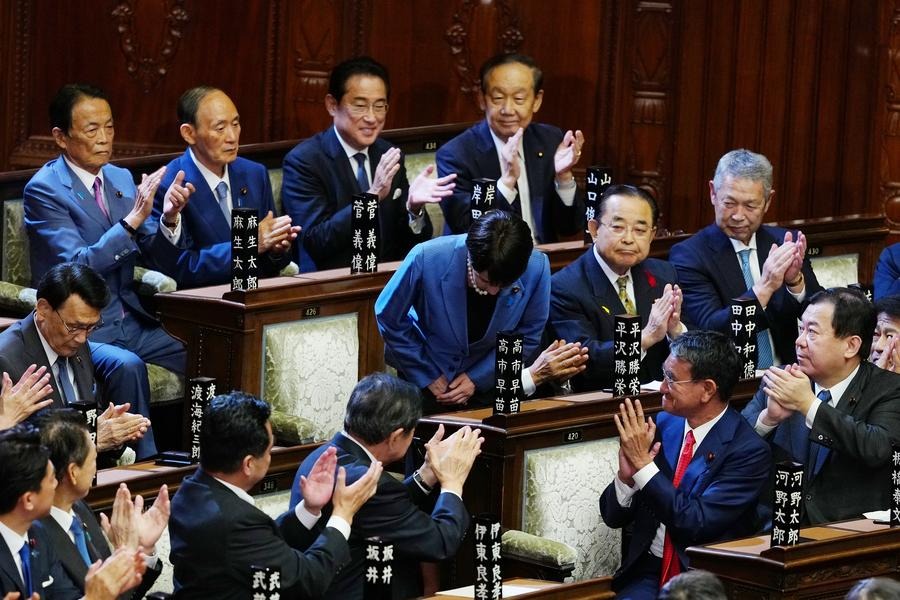The facts and China's position on China-US trade friction

7. China is firmly committed to mutually beneficial cooperation with other developed and developing countries.
China will work with the EU to expedite and strive for early consensus in the negotiations on the China-EU Investment Agreement, and, on this basis, take the China-EU FTA onto the agenda. China will accelerate negotiations on the China-Japan-ROK Free Trade Area and work for early conclusion of the Regional Comprehensive Economic Partnership (RCEP). China will promote deeper cooperation under the framework of the Belt and Road Initiative based on the principles of consultation, cooperation and benefit for all, and make efforts to achieve policy, infrastructure, trade, financial, and people-to-people connectivity and create new drivers for common development.
8. China is firmly committed to building a community with a shared future for mankind.
Faced with a host of grave challenges to human progress, all countries, particularly major countries, need to shoulder the obligation and responsibility of guiding and promoting international cooperation. Countries should respect each other, engage in discussions as equals, and resolutely reject the Cold War mentality and power politics. Countries should not engage in a zero-sum game that puts one's self-interest first and sees others' gains as one's losses, nor should they follow a hegemonic approach that advocates beggar-thy-neighbor policies and believes in the strong bullying the weak. Instead, countries should manage differences and tensions properly, settle disputes and disagreements through dialogue and consultation, and replace estrangement with exchange, clashes with mutual learning, and superiority with coexistence among civilizations. China will continue to act as a responsible major country, and join every other country in building an open, inclusive, clean and beautiful world that enjoys lasting peace, universal security and common prosperity.
"A just cause enjoys abundant support while an unjust one finds little support." In a world of increasing uncertainty, instability and insecurity, China will remain true to its original aspiration, follow the trend of the times, shoulder its responsibility for justice, and pursue the greater good. It will unswervingly safeguard the multilateral trading system, press forward with the reform of global governance, promote world peace, contribute to global development, uphold international order, and build a community with a shared future for mankind.
1 United Nations Commodity Trade Statistics Database.
2 US China Business Council& Oxford Economics: Understanding the US-China Trade Relation, 2017 Jan.
3 US China Business Council& Oxford Economics: Understanding the US-China Trade Relation, 2017 Jan.
4 US-China Business Council& Oxford Economics, Understanding the US-China Trade Relation, 2017 Jan.
5 China Association of Automobile Manufacturers (http://www.auto-stats.org.cn).
6 General Motors (http://www.gmchina.com).
7 Intel Co. (http://www.intel.com).
8 Apple Inc. (http://www.apple.com).
9 Research Report on China-US Trade and Economic Relations, page 31, MOFCOM.
10 Goodman Sachs (http://www.goldmansachs.com), Made in US…..or China? 25 Years Supply Chain Investment at a Cross Roads, May 2017.
11 Chinese tech isn't the enemy, Anja Manuel, The Atlantic, Aug 1, 2018.
12 Deutsche Bank,"Calculating the Economic Interests of the US and its Major Trading Partners", June 2018.
13 Carnegie Endowment for International Peace, "Political Barriers in US Exports to China and US-China Trade Deficit", April 10, 2017.
14 Barry Eichengreen, 2011, Exorbitant Privilege: The Rise and Fall of the Dollar and the Future of the International Monetary System, Oxford University Press.
15 National Bureau of Statistics of China.
16 National Bureau of Statistics of China.
17 Strategy, PWC, The 2017 Global Innovation 1000, 2017.
18 Cornell University, INSEAD, WIPO, Global Innovation Index 2018, 2018.
19 National Bureau of Statistics of China, Statistical Communiqué for the People's Republic of China on the 2017 National Economic and Social Development, published on February 28, 2018.
20 The State Council Information Office of China, Press Conference on China's intellectual property rights development in 2017, April 24, 2018.
21 Larry Summers praises China's state investment in tech, saying it doesn't need to steal from US, CNBC,27June, 2018.
22 China and the World Trade Organization, June 2018, the State Council Information Office.
23 Data from the Supreme People's Court of the PRC.
24 Status of Protection of Intellectual Property Rights in China 2016, SIPO.
25 SIPO, Statistics Yearbook 2012, Patent Work and Comprehensive Management Statistics Monthly Report 2017, the figure for 2017 is invention patent applications.
26 Trademark Office of SAIC, China Trademark Branding Strategy Annual Development Report 2017.
27 Nicholas R. Lardy, China: Forced Technology Transfer and Theft?, Peterson Institute for International Economics, April 20, 2018.
28 Official website of the Chinese government (http://www.gov.cn).
29 American Enterprise Institute (http://www.aei.org), Chinese investment in the US.
30 Indicators of Product Market Regulation measure the extent to which policy settings promote or inhibit competition in the product market. A higher score indicates greater hindrance. The indicators are computed based on three indicators-state control, barriers to entrepreneurship and barriers to trade and investment. Since 1998, the indicators have been computed every five years-in 1998, 2003, 2008 and 2013. Data were collected through surveys filled in by officials from relevant countries. The statistics cover 35 OECD countries and 12 non-OECD countries. Products covered by the statistics also include some services.
31 Differential Treatment of Foreign Suppliers is a secondary indicator for barriers to trade and investment in the indicators of product market regulation. It is computed based on the evaluation of restrictions on shipping, land transport and air transport, on foreign professionals, on appeals by foreign entities, on anti-competition behavior, regulatory policy barriers and trade facilitation measures. It reflects the extent to which a country's market discriminates against foreign products. A higher score indicates greater discrimination.
32 OECD (http://www.oecd.org).
33 The White House (http://uscode.house.gov), Buy American Act. The act has also made additional stipulations for waivers.
34 The White House (http://uscode.house.gov), Buy American Act. The act has also made additional stipulations for waivers.
35 The US Congress (https://www.congress.gov), Agriculture, Rural Development, Food and Drug Administration, and Related Agencies Appropriations Act.
36 The US Congress (https://www.congress.gov), National Defense Authorization Act.
37 The US Congress (https://www.congress.gov), Foreign Investment and National Security Act of 2007.
38 Based on CFIUS' annual reports to Congress (https://www.treasury.gov)
39 The US Department of the Treasury, November 21, 2008.
40 The US Congress (https://www.congress.gov).
41 Good jobs first (https://www.goodjobsfirst.org), March 2015.
42 Good jobs first (https://subsidytracker.goodjobsfirst.org).
43 Good jobs first (https://subsidytracker.goodjobsfirst.org).
44 The US Department of the Treasury (https://www.treasury.gov).
45 The US Department of Energy (https://www.energy.gov).
46 Good jobs first (https://subsidytracker.goodjobsfirst.org).
47 Joseph W. Glauber and Patrick Westhoff: "The 2014 Farm Bill and the WTO", American Journal of Agricultural Economics, 2015.
48 Randy Schnepf: "Farm Bill Provisions and WTO Compliance", Congressional Research Service, April 22, 2015.
49 Randy Schnepf: "Farm Safety-Net Payments Under the 2014 Farm Bill", Congressional Research Service, August 11, 2017.
50 The UNCTAD (http://unctad.org).
51"US-China Trade-Eliminating Non-Market Economy Methodology Would Lower Anti-dumping Duties for Some Companies", a report by the GAO in 2016.
52 Gary Horlick, deputy assistant secretary of the International Trade Administration of US from 1981-1983, talked about the selection of surrogate countries in a Ways and Means Committee hearing. Horlick described the selection as based on perception. For instance, in a towel case with China, the US listed Pakistan, Thailand, Malaysia, the German Democratic Republic, Colombia and India as surrogate countries, for no apparent reason.
53 Section 232 investigation is conducted by Department of Commerce on the basis of the authorization by Section 232 of the Trade Expansion Act of 1962 to determine whether the importation of an article in question threatens the national security of the United States. A report is presented to the President within 270 days of initiation. The US President makes a determination on whether to take final measures on the imports concerned within 90 days.
54 Chad P. Bown@ChadBown, May 27, 2018.
55"Section 201" refers to Sections 201-204 of the US Trade Act of 1974. According to the section, the United States International Trade Commission (USITC) initiates global safeguard investigations to determine whether an article is being imported in such increased quantities as to be a substantial cause of serious injury, or the threat thereof, to the domestic industry and presents a report and recommendations to the President within 120 days of initiation. Based on the authorization of law, the President makes a determination on final measures within 140 days of receipt of the USITC report.
56 "Section 301" refers to Section 301 of the US Trade Act of 1974. According to the Section, the US may initiate investigations against trade practices of other countries it deems "unjustifiable" and negotiate with relevant governments. The President may make a final decision to retaliate through imposing duties or other import restrictions, or suspending relevant agreements.
57 Peterson Institute for International Economics (https://piie.com): "Rogue 301: Trump to Dust Off another Outdated US Trade Law?"
58 Robert H. Wade: "The American Paradox: Ideology of Free Markets and the Hidden Practice of Directional Thrust, Cambridge Journal of Economics, May 2017.
59 The Executive Office of the President of the US, December 2009.
60 The Executive Office of the President of the US, August 2010.
61 The Executive Office of the President of the US, June 2011.
62 The National Association of Manufacturers of the US, December 2011.
63The Executive Office of the President of the US and National Science and Technology Council, February 2012.
64 The Executive Office of the President of the US, 2011.
65 The Executive Office of the President of the US, National Science and Technology Council, Advanced Manufacturing National Program Office, January 2013
66 The US Department of Energy, April 2013.
67 The Office of Science and Technology Policy of USA, March 2013.
68 The National Institute of Standards and Technology of USA, May 2013.
69 The National Science and Technology Council, October 2016.
70 The Center for Strategic and International Studies, March 2018.
71 Wayne M. Morrison: "China-US Trade Issues", March 6, 2017, Congressional Research Service.
72 Ball State University, The Myth and the Reality of Manufacturing in America, June 2015.
73 Arie Reich: "The effectiveness of the WTO dispute settlement system: A statistical analysis", Department of Law, European University Institute, November 2017.
74 Donald J.Trump@realDonaldTrump, January 3, 2017.
75 Donald J.Trump@realDonaldTrump, July 3, 2018.
76 CNN News (https://www.cnn.com), April 3, 2018.
77 Peterson Institute for International Economics (https://piie.com).
78 Peterson Institute for International Economics (https://piie.com), "Trump, China, and Tariffs: From Soybeans to Semiconductors", June 18, 2018.
79 New York Times (https://nytimes.com),"What a Trade War With China Looks Like on the Front Lines".
80 Reuters,"Impact of US-China trade tariffs on US companies", July 30, 2018
81 Huffington Post (https://www.huffingtonpost.com),"Largest US Nail Manufacturer Could Soon Be Out of Business Because of Trump Tariffs", June 29, 2018.
82 Peterson Institute for International Economics (https://piie.com),"Trump's Proposed Auto Tariffs Would Throw US Automakers and Workers Under the Bus", May 31, 2018.
83 The US National Taxpayers Union (https://www.ntu.org), May 3, 2018.
84 The Alliance of Automobile Manufacturers (https://autoalliance.org),"Comments of the Alliance of Automobile Manufacturers on the Section 232 National Security Investigation of Imports of Automobiles, Including Cars, SUVs, Vans and Light Trucks, and Automotive Parts", June 27, 2018.
85 NBC News
86 The Charlotte Observer (https://www.charlotteobserver.com), "How the Carolinas Could Suffer from Trump's Tariffs", June 21, 2018.
87 Bloomberg (https://www.bloombergquint.com), June 25, 2018.
88 Adam S. Posen, "The Cost of Trump's Economic Nationalism: A Loss of Foreign Investment in the United States", July 24, 2018.

































